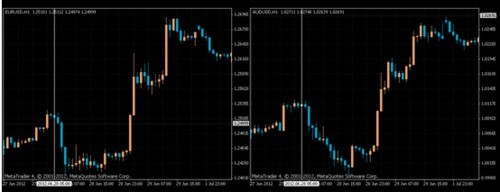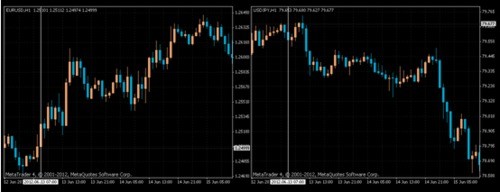Currency correlation happens when the price of two or more currency pairs moves in conjunction with one another. There can be
both positive correlation, where the price of the currency pairs moves
in the same direction and negative correlation, where the price of the
currency pairs moves in opposite directions.
As a forex trader, it is important to understand the relationship between currency pairs, because currency correlation can affect the exposure and risk to your trading account
Currency pairs incorporate two economies
Currency pairs are made up of two separate currencies and they are
valued in relation to each other. Each currency belongs to an economy
that can affect the supply and demand of it. If the value of one
currency increases (or decreases), it increases (or decreases) across
the board against all other currencies, not just a single one. For
example, if the euro increases in value against the US dollar, it is
likely to increase in value against all other currency pairs as well,
not just the US dollar. This means that currency pairs cannot be traded
in isolation.
This does not mean that a currency value will change at the same rate against all other currency pairs. For example, if the euro rises against the US dollar by 100 pips, it does not mean that there will be a 100 pip increase against the Australian dollar. However, it will likely rise against the Australian dollar to a certain degree.
Positive correlation
Positive correlation means that two currencypairs move in the same direction – if one currency pair moves up, so does the other. To illustrate this, let’s take the example of the EUR/USD and the AUD/USD.
Positive Correlation

The EUR/USD is made up of the euro and the USdollar. If the price of the EUR/USD increases, this can mean that either the euro is in more demand or the dollar is in less demand. Either scenario will result in the price of the euro increasing against the dollar.
If there is less demand for the US dollar, thenthere will also be less demand for the US dollar against other currency pairs, because there will be less demand for the US dollar overall – it does not become weaker against one currency only.
If the EUR/USD increases because the USD hasbecome weaker, you can
expect that the AUD/USD will also increase. This is an example of a
positive correlation between the EUR/USD and AUD/USD.
Negative correlation
Negative correlation means that two currenciesmove in the opposite direction to each other – if one currency pair moves up, the other moves down. To illustrate this, let’s use another example, this time of the EUR/USD and USD/JPY.
Negative Correlation

If the demand for the dollar decreases, then the price of the EUR/USD will increase, where as the USD/JPY will decrease. This is because the price of the USD is denoted differently for these two currency pairs. US dollar weakness will be shown as an increasing price for the EUR/USD and seen as a decreasing price for USD/JPY.
Trading more than one pair at a time
Due to correlation between different currency pairs, there are
considerations that you have to take into account when trading more than
one currency pair.
Currency correlation can increasethe overall risk to your trading account
Let’s say that you risk 2% of a trading account on a single trade. If
you open a long position on both the EUR/USD and the GBP/USD,
then it would appear that you have opened up two trades with a 2% risk on each.
However, because there is a positive correlationbetween the EUR/USD and GBP/USD, if one currency pair moves in one direction,
the other currency pair is likely to as well. This means that if one
currency pair moves against your trade, the other will too. Because you
have risked 2% on each trade that is correlated, this is effectively the
same as risking 4% on a single trade.
Correlating trades can cancel eachother out
If a trader opens up a long position on the EUR/USD and a short position
on the GBP/USD, then because they are likely to move in the same
direction, one will produce a profit and the other will produce a loss.
Any profit made on one trade would be offset by the loss on the other.
Opening up opposite positions on a strongly correlated currency pair is counter-productive.
Similarly, if a trader opens the same position on a negatively correlating pair, such as the EUR/USD and the USD/JPY, then if one position results in a profit, the other will result in a loss. Any profit gained on one trade is likely to be offset from the loss on the other. The correlation betweencurrency pairs is not exact. Depending on the fundamentals behind them, a currency correlation can become stronger or weaker – they can also break down completely. The financial industry generally measures correlations using a scale from +1 to -1:
+1 = perfect positive correlation
-1 = perfect negative correlation
0 = no correlation at all
You can use a correlationtable to quickly see the correlation between a range of currency pairs. The following table demonstrates the extent of the correlations between different currency pairs (please note this is just an example):

From the table it can be seenthat over the course of a year, the
EUR/USD had a near perfect correlation with the AUD/USD, at a
correlation measurement of 0.93. However, in a shorter time period, the
currency had a weaker correlation measurement of just 0.5.
Traders can use tables such asthese to determine correlations when
trading more than one currency pair in the time frame they are trading
in.
Using currency correlation to your advantage
Currency correlationcan hold advantages when trading, because observing
one currency pair can give you an insight into another, if they are
correlated.
Confirming trades and analysis
Correlation can be used to confirm a trade, or your analysis, on a
particular currency pair. Correlation is never exact and so you are
looking for the same ‘kinds’ of moves, but they will not be exactly the
same for each currency pair.
The idea is to look at whether the positively correlating pairs are moving together with the currency pair that you are watching. So if you are observing a currency pair move down, you can use other currency pairs that positively correlate to see if they are also moving down,confirming that your analysis is correct.
Avoiding bad trades
Correlation can also be used to keep you out of bad trades, such as a false breakout.
If you are observing a currency pair that has been in a range and you observe a breakout to the upside, you can use positively correlating pairs to see if they have also broken to the upside.



